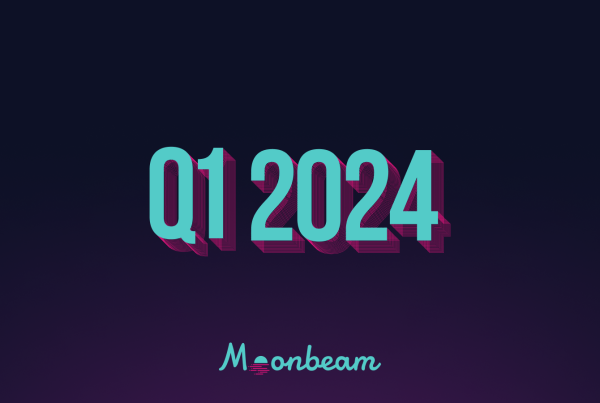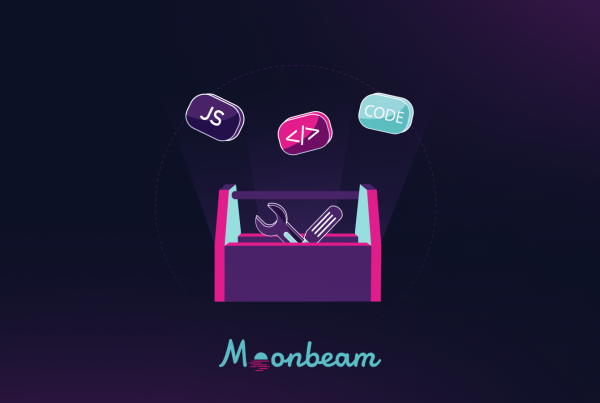Introduction
Blockchain’s core capabilities, like transparency, immutability, decentralization, and trustless automation, have immense potential to drive innovation that helps address the climate crisis. Blockchain can realign incentives, reshape capital flows, and enable coordination at an unprecedented global scale. Regenerative Finance (ReFi) harnesses these capabilities to help create a more sustainable world.
TL;DR
- Regenerative Finance (ReFi) Explained: ReFi is an ambitious financial approach that aligns profits with eco-friendly sustainability.
- Regenerative vs Extractive: ReFi rejects extractive models that deplete finite resources, instead embracing regenerative systems.
- ReFi Goes Back to DeFi: ReFi leverages blockchain’s transparency and automation to enable positive outcomes and align incentives.
- Moonbeam; Well-Suited for ReFi Solutions: Moonbeam’s high throughput, Ethereum compatibility, and cross-chain integration make it an ideal platform for building and scaling ReFi solutions.
- Introducing ReFi Hub on Moonbeam: ReFi Hub is an innovative ReFi platform built on Moonbeam, aiming to direct over $1 billion into environmental projects by 2030.
- A Regenerative Future: ReFi Hub demonstrates how decentralized tech can reshape incentives and capital flows to support planetary regeneration.
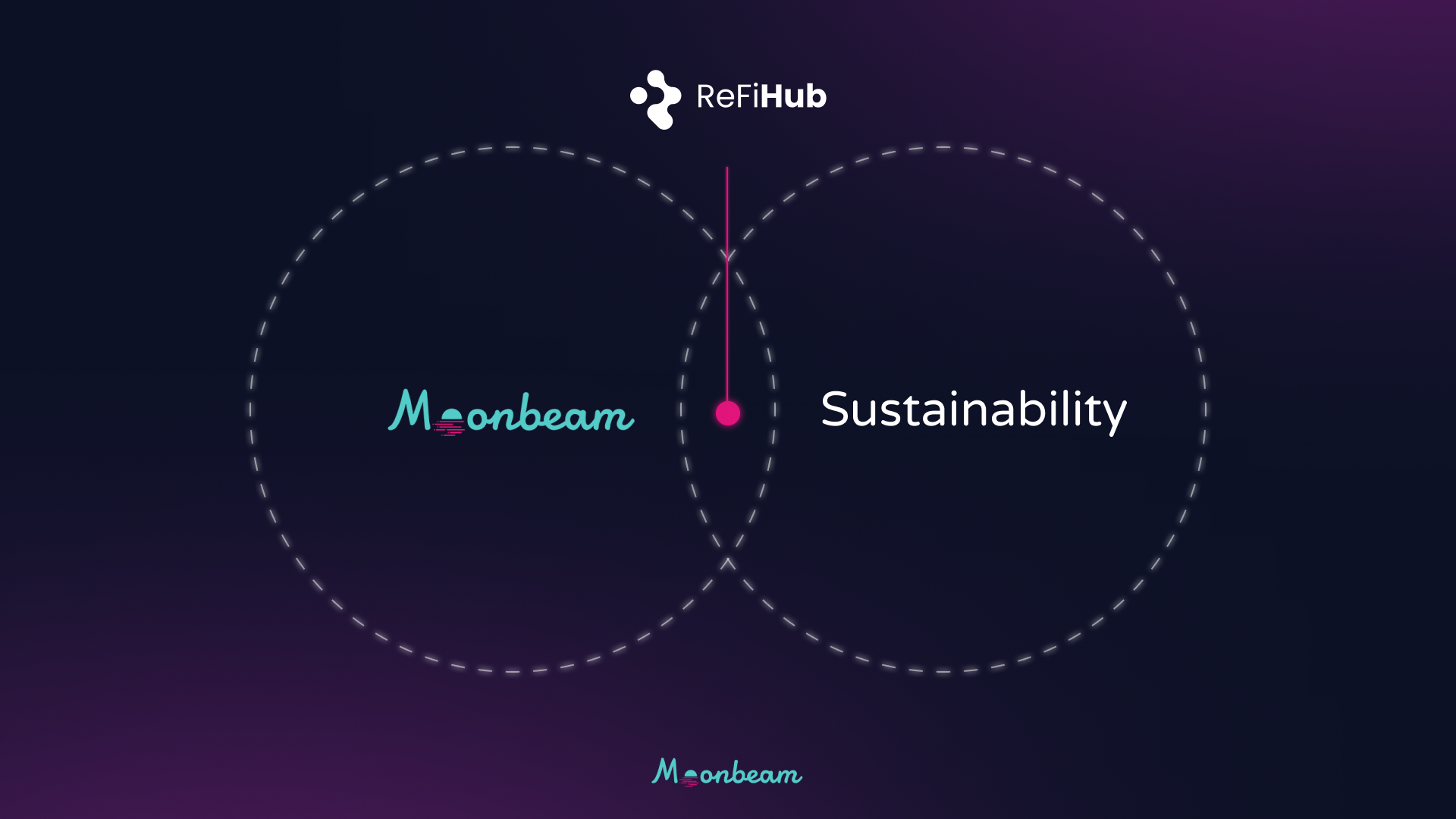 Regenerative Finance (ReFi) Explained
Regenerative Finance (ReFi) Explained
Decentralized Science (DeSci) and Decentralized Physical Infrastructure (DePin) are both emerging niches within the decentralized world, and Regenerative Finance (ReFi) is emerging alongside them. ReFi is an ambitious financial approach that aligns profits with eco-friendly sustainability. At its core, ReFi aims to embed care for communities, ecosystems, and our environment into economic systems, enabling sustainable value creation, exchange, and distribution. By aligning the right incentives, ReFi can forge economic systems that simultaneously generate returns and regenerate the natural world.
While sustainability is key, ReFi is also about maintaining a steady state of resource availability, exploring how we can be regenerative rather than extractive, and creating economic, financial, and technological infrastructures that actively restore the world’s depleted assets and capacities. This forward-looking philosophy positions ReFi as an evolutionary shift in human coordination, prosperity, and well-being for future generations.
Regenerative vs Extractive
As mentioned, part of the core premise of ReFi is the belief that our economic systems should regenerate rather than extract value over time. Extractive models focus on the depletion of finite resources for short-term gains, diminishing ecosystems and communities. In contrast, regenerative systems enhance overall capacities and resilience. They recover from shocks, maintain stability, and grow stronger – replenishing the very sources from which they derive value. This fundamental distinction is at the heart of ReFi’s bold rethinking of how we create, distribute, and multiply capital of all forms – financial, natural, social, and beyond. ReFi rejects the extractive, zero-sum thinking model, instead embracing a full-cycle, regenerative, and ultimately expansive paradigm.
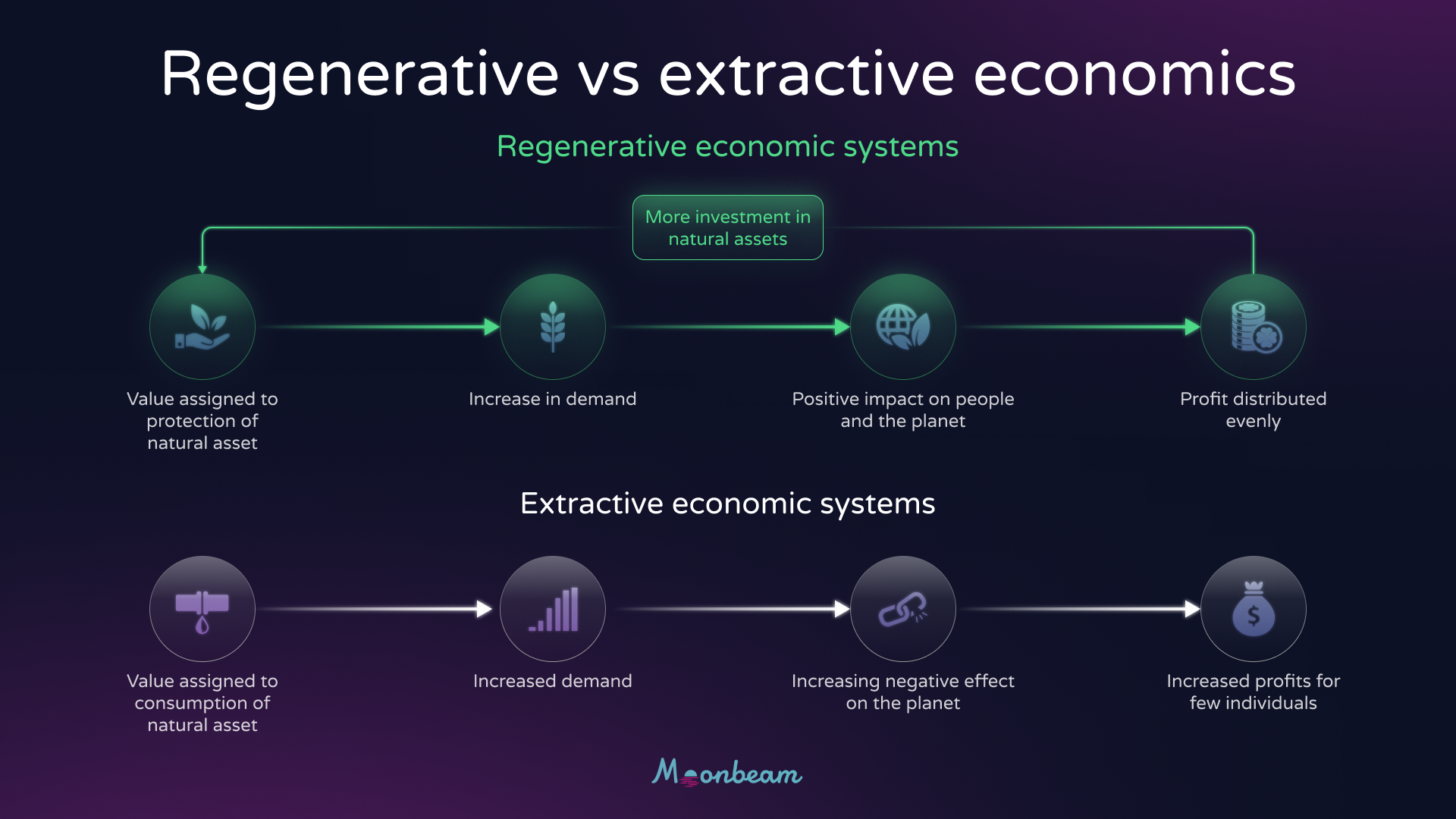 ReFi Goes Back to DeFi
ReFi Goes Back to DeFi
At its foundation, ReFi leverages many of the key innovations that have driven the growth of Decentralized Finance (DeFi). The characteristics of blockchain-based systems provide the ideal digital infrastructure for ReFi. While ReFi utilizes the blockchain and smart contracts, its impacts are tangible in the real world.
ReFi allows people globally to coordinate and pool resources across borders, design products that serve local community needs, and build services that directly accelerate climate action and environmental regeneration. The transparency and automation of blockchain enable these positive real-world outcomes by reducing friction and aligning incentives. This powerful digital/physical intersection gives ReFi its unique potential.
Moonbeam; Well-Suited for ReFi Solutions
Moonbeam provides an ideal platform to build and scale ReFi solutions. The high transaction throughput powered by parallel processing gives ReFi dApps the ability to handle significant volumes of usage and adoption. Moonbeam’s Ethereum Virtual Machine (EVM) compatibility leverages the existing Ethereum developer ecosystem and tooling. This lowers the barriers to entry and enables projects to build ReFi protocols and applications with established standards.
Moonbeam is also built on the scalable and interoperable Substrate framework, providing powerful cross-chain capabilities. This cross-chain functionality is critical for ReFi, enabling connectivity between regenerative projects, supply chains, carbon markets, and other sustainability efforts operating across different blockchain networks. Moonbeam’s combination of high scalability, EVM + Substrate compatibility, and cross-chain integration make it an ideal technological foundation for accelerating innovation in the ReFi space.
Introducing ReFi Hub on Moonbeam
At the intersection of sustainability, Moonbeam, and DeFi lies ReFi Hub, an innovative platform aiming to direct over $1 billion into environmental sustainability efforts by 2030 using blockchain technology. As a pioneering ReFi project, ReFi Hub is proving that blockchain technology can be a powerful catalyst for restoring the planet. The ReFi Hub team previously built CoralTribe, a project harnessing the power of NFT art to impact the environment and natural world while incentivizing holders with shared revenue. The Coral Tribe community has played a vital role in successfully planting over 2,550 corals, benefiting more than 4,500 individuals through various means such as education, scientific research, job creation, and diving.
The Profit + Planet Paradigm
ReFi Hub embodies the core ReFi principle that profit and environmental protection synergies when properly incentivized. As their motto states, they are “Breaking the Myth” that these goals must be separate, instead combining them to “forge something extraordinary.”
There are increasing signs that regenerative policies, finance, and culture are taking hold, from governments racing to meet carbon targets to the impact investing market surpassing $1 trillion in assets. ReFi Hub is at the forefront of this movement, leveraging blockchain to drive capital into businesses and projects that tackle the climate crisis head-on.
The ReFi Hub Platform
Operating as a DeFi lending protocol that tokenizes real-world environmental assets, ReFi Hub creates a transparent marketplace for “climate investing.” Their rigorously vetted platform allows anyone to invest as little as $1 into regenerative businesses working in areas like renewable energy, aquaculture, and sustainable BTC mining.
To participate, investors purchase iRWAs (Investments in Real-World Assets), tokenized loan agreements that directly fund approved borrowers. Those businesses then utilize the funds for their operations, regularly repaying interest and principal to a smart contract that iRWA holders can claim rewards. All loans are repaid in USDC, providing a stable and secure investment.
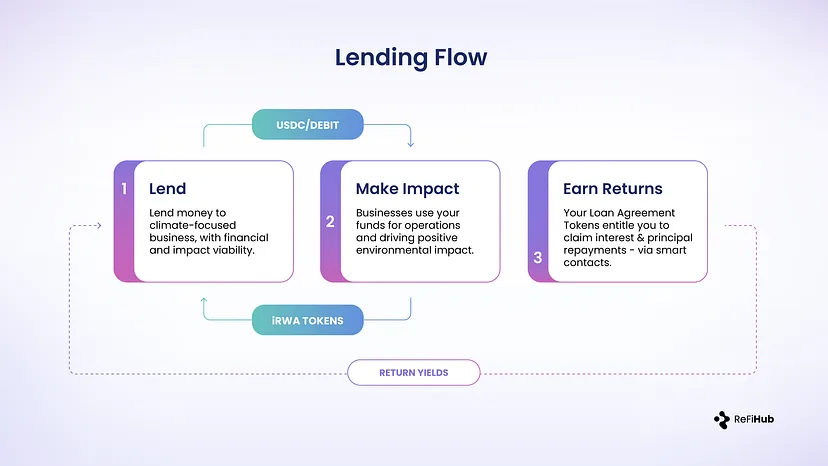 ReFi Hub goes to great lengths to ensure the security and reliability of investments on its platform through stringent business vetting, collateralized and guaranteed loans, and full transparency into borrowers’ operations.
ReFi Hub goes to great lengths to ensure the security and reliability of investments on its platform through stringent business vetting, collateralized and guaranteed loans, and full transparency into borrowers’ operations.
Measuring Tangible Impact
More than facilitating financial transactions, ReFi Hub quantifies the tangible environmental impacts created through their platform by monitoring metrics like tonnes of CO2 averted, plastic waste removed from oceans, clean energy produced, sustainable jobs created, and supply chain transparency.
This data empowers users to see how their money makes a difference. ReFi Hub has already helped avert 293 tonnes of CO2, funded 4 global regenerative projects, is backed by a 650K community fund, and built a community of 10,000+ investors, proving that restoring the planet is profitable. As a cross-chain platform built on Moonbeam, ReFi Hub benefits from high throughput, Ethereum compatibility, and seamless cross-chain integration – critical capabilities at the intersection of DeFi and real-world sustainability projects.
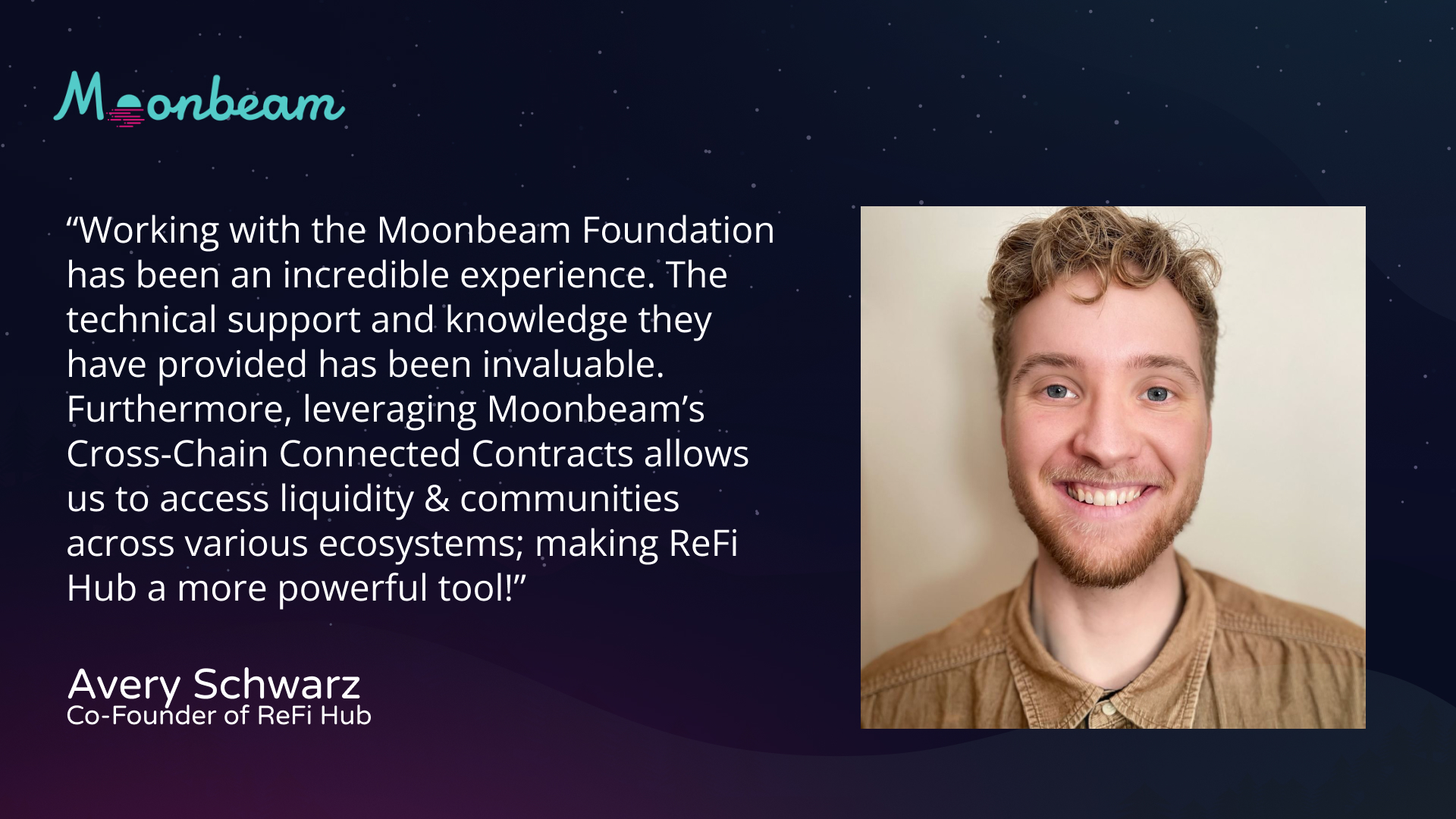 A Regenerative Future
A Regenerative Future
With its pioneering combination of blockchain transparency, careful project vetting, and tangible impact tracking, ReFi Hub is charting a course for how decentralized technologies can reshape incentives and capital flows to support planetary regeneration.
As awareness of ReFi grows, innovators like ReFi Hub demonstrate that profit and environmental responsibility need not be at odds but can be fused into an extraordinary new paradigm. By embedding care for communities and ecosystems into the core design of economic systems, ReFi represents an evolutionary shift that could be key to human flourishing in the 21st century and beyond.


